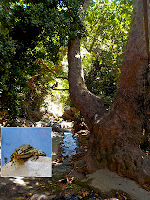Feeling
bored yet? If you're missing the big wide world outside of your front
door, go out of the back door instead. There's another, even more
wonderful world, in the back garden. Whether it's a beautifully
manicured lawn with regimented borders, or looks a bit like a
bombsite, there's a host of interesting creatures out there waiting
to be investigated. Birds, bats, butterflies; molluscs, mice and
moths; the list is almost endless. As I proved, from a hospital
balcony a few years back, you can be a naturalist anywhere. See How
To Be A Naturalist, Anywhere
Small
mammals, amphibians and reptiles are great favourites and there are a
number of ways in which you can observe these. A small garden pond
will often attract frogs and toads, as well as providing a source of
water for other creatures. A bird feeder will attract a host of
garden birds, but if you can't get out to buy wild bird seed at the
moment, a simple platform with household scraps (fruit is a
favourite) will bring them in. A small mammal trap is best for things
like mice and shrews but an alternative is to bury a bucket in soft
earth, bait it with something tasty, then cover it with wood, propped
up about an inch at one end. You will probably also get a fair few
snails. If your finances run to a camera trap, then you can get
photos of some great nocturnal creatures as well, like this Stone
Marten who visited my bird table one night.
My
own personal passion is, as you probably know by now, the insect
world. Did you know that there are about thirty different orders of
insects and hundreds of different families making up those orders?
About five years ago, I wrote a post giving a quick run-down on how
and when those insect orders evolved. I ended the post with this
picture of twelve of the most common orders that you are likely to
find in your back garden. See Whiffling
through the Woodpile – a short history of insects
This
proved to be a very popular post and eventually led to me writing The
Quick Guide To Creepy-Crawlies which not only gives pictures and
easy descriptions of twentytwo of those insect orders (in both their
adult and juvenile states), but also pages of molluscs, myriapods,
isopods and all the other creepy-crawlies that you are likely to find
in your garden. Suitable for adults and children alike, I am putting
it on special offer (a third off, except in the USA where a minimum
price applies) until the end of April. So, order a copy, take your
camera or phone out of the back door, photograph what you find, and
identify them when the book arrives. Congratulations!
You've
just got yourself a new hobby!
Was
£14.99 $17.31 €16.14
Now
£10.00 $16.48 €11.52
Due
to a technical problem at facebook, many people did not see last
week's post. If that includes you, you can read it here: It's
a Small World (microscpically small – all about the unseen
world of Archaea, Bacteria and Viruses).
|
Crete
Nature Catch-up
|
||
|
The
Eggs of Saramova A science fiction novella for those who don't like science fiction. A fast-paced thriller that is, literally, out of this world (and it starts right here in Crete). The Quick Guide to Creepy-Crawlies All you need to know to identify any type of insect, spider, worm or snail very simply and find out more about it. Not Just For Twisted Women by Steve Daniels A light-hearted look at life through the eyes of the fairer sex. |
See sample pages of all my books and latest blogs and keep
abreast of latest publications here: http://author.to/SteveDaniels |
*********************************************************************
LINKS:
Share
your nature thoughts, photos and comments on Naturalists
(the
facebook page that accompanies this blog)
Explore
the region with the #CreteNature interactive Hiking
and Nature Map









